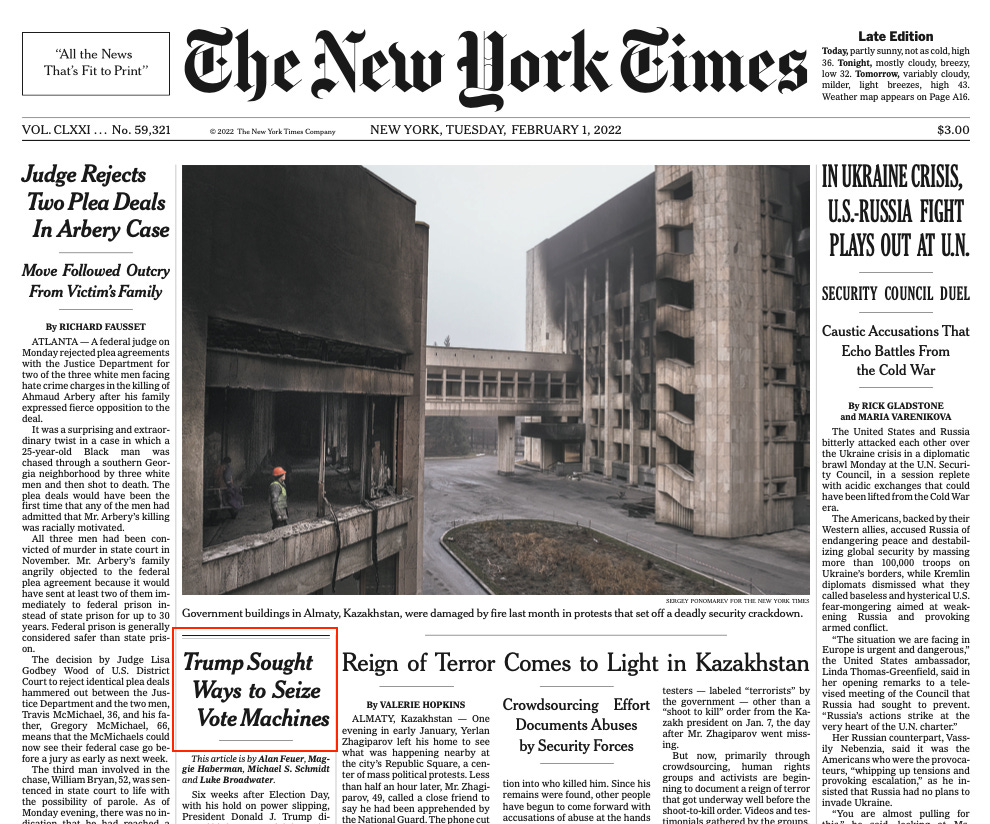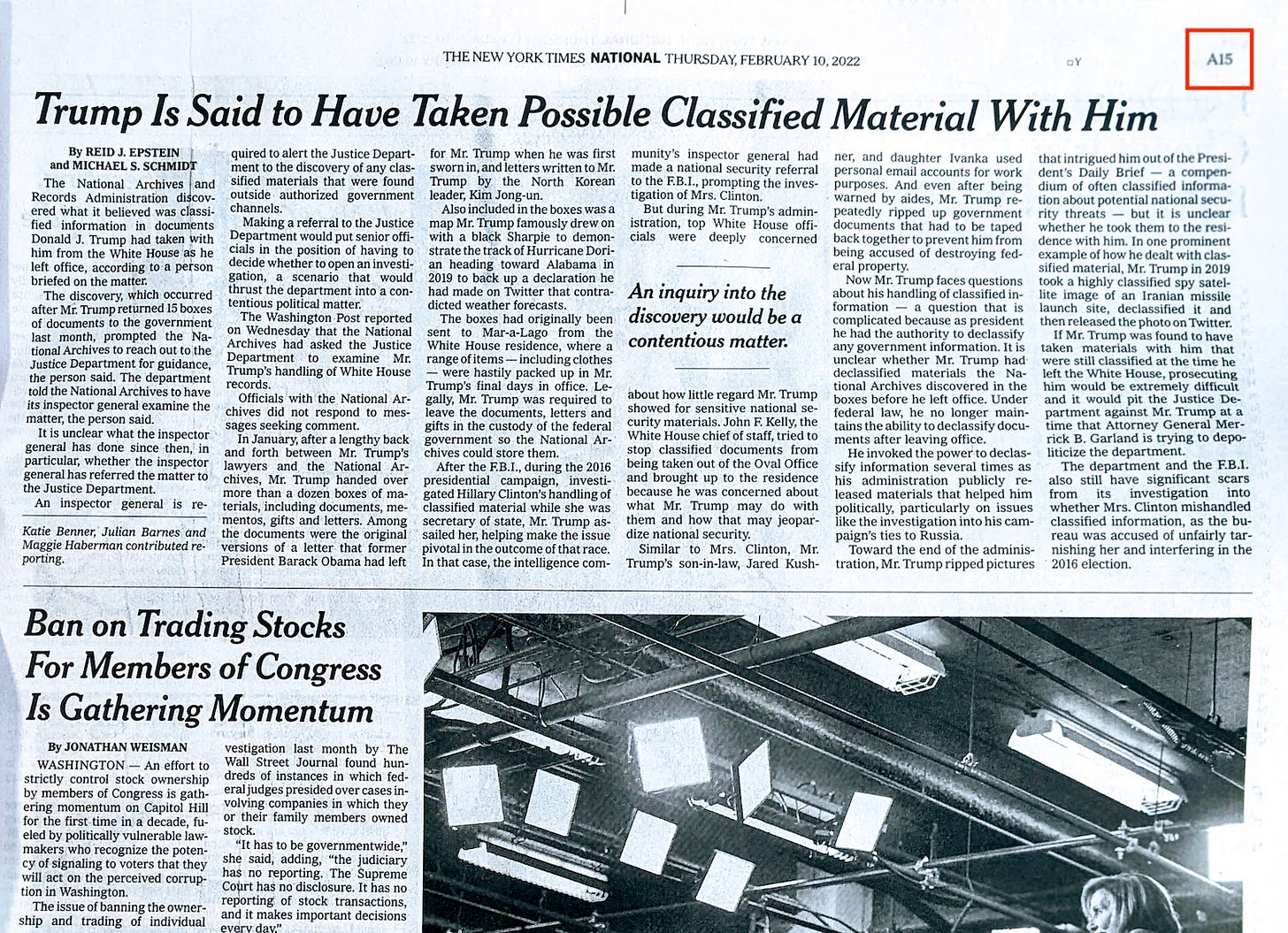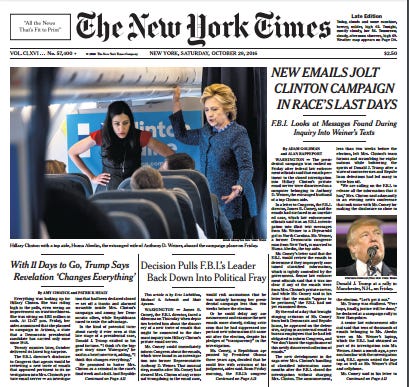‘Framing the News’: An Update
The power and peril of two recurring themes: ‘Nothing Works,’ and ‘That’s Just Trump.’
This post continues the theme of the previous one, on the value of noticing “frames” for the news, beyond the normal attention to “bias” and “balance.”
As a reminder, framing involves the unstated, sometimes unconscious assumptions that reporters and editors bring to a story, and why these can make a bigger difference than more visible expressions of partisan slant.
It’s easy for reporters, editors, or talk-show hosts to meet formal requirements for “balance,” by quoting both Republicans and Democrats. It’s harder to recognize the imbalance built into countless story decisions.
For instance, as Doug Mack memorably described, through the Trump era news outlets presented interviews in Appalachian and Midwestern diners, with a typically older and whiter clientele, as a proxy for under-represented “real” American views. We heard fewer drop-in reports from, say, the “real” America of barbershops in Black neighborhoods of Detroit or Oakland, or community centers in Latino areas in Iowa or Kansas.
My purpose today is not to re-explain the idea. For more details, please see some of the many works and writers mentioned below.1 Instead I want to give recent examples of two important, unconscious, and consequential story lines, or frames. The first is based on a positive recent illustration. The second is the reverse.
Story-line 1: ‘Nothing Works’ in ‘This Town’
The safest thing anyone can say or write about Washington D.C. is that it is “a mess.” A monument to gridlock. The place where careerism thrives, and hope and idealism go to die. A sewer, a swamp, a distillation of what is most dysfunctional in public life.
Very obviously a lot of activity at the national level fits exactly this pattern. The secret deals that are made, the insincere poses that are struck. This has been a reality of high-stakes political life for a long time. Nearly 150 years ago it was the theme of the novel The Gilded Age, by Mark Twain and Charles Dudley Warner. Given the title, modern Americans might assume the book is about plutocrats. It’s really about Washington deal-making.
Most politicians who have ever run for any office have at some point inveighed against “the mess in Washington.” Gilded Age onward, most Washington-based fiction has emphasized its cynical corruption. So have most DC-themed movies and TV shows. In this sense House of Cards conformed to the prevailing rule. The West Wing illustrated the exception.
But in a story published today in The New Republic, Timothy Noah stresses the difference between recognizing that too much of Washington life is this way, and assuming that all of it is. (For the record: Tim Noah is a long-time friend.)
The article is called “Washington Is Not a Swamp,” and you can read it here. I recommend it because of the original reporting that went into it, and the even-more-original argument it presents. But I also recommend it as a cause for reflection and discussion among people responsible for framing the news—and people affected by those frames.
Although Tim Noah doesn’t spell it out this way, for me his story highlights a distinction that may seem small but has enormous consequences. That is the difference between circumstances seeming terrible, and their seeming hopeless. This applies in personal life, in family relations, in organizational and community resilience and ambition, and in the life of a culture.
—When conditions are terrible, people have a challenge, a goal, a reason to redouble their efforts. You can think of a million examples of against-all-odds comebacks in the sporting world, in business sagas, in military and political sagas. When the going gets tough…
—But when conditions are hopeless, there’s no reason to try. You disengage. You wall yourself off. You shrink your circle of trust. You watch it all burn.
The frame of many stories about “the mess in Washington” is that public life is hopeless. Nothing works, and nothing can. Tim Noah’s story argues: many things don’t work, but some things do—and here is what we can learn from them, even as we consider what has failed.
I’ll offer a sample. Noah cites Mark Leibovich’s Gilded Age-style book This Town and says why he disagrees with its portrayal:
“Here’s the problem with Leibovich’s Washington. His survey excluded virtually all the metropolitan area’s roughly 283,000 civil servants; virtually all its 172,000 military personnel; most of its 36,700 D.C. city workers; and most of its 591,000 do-gooders working for nonprofit organizations. That’s more than a million people, living in and around a capital whose population is 670,000. Let’s call them the Asknots, in memory of President John F. Kennedy’s inaugural plea, “Ask not what your country can do for you, ask what you can do for your country.”
“The Asknots are the people I’ve known as neighbors in Washington over four decades… As a tribe, Asknots are upright, kind, capable, and public-spirited. There are exceptions, of course. But in general, Asknots are exactly the sort of people you like to have as neighbors. I’m fortunate to count many as friends.”
I hope you’ll read and think about the whole piece.
Story-line 2: ‘That’s Just Trump’
By definition news highlights the abnormal. The man who bites a dog, not the dog that bites a man. The train that goes off the track, not the ones that stay on.
But the framing of news stories also conveys powerful assumptions about what is normal. What are the conditions that don’t need to be mentioned, because we can expect them? What’s within the taken-for-granted, unremarkable range?
In the previous post I gave illustrations of a frame I called “Grading on the Curve,” in mainstream press treatment of Donald Trump and his apologists. Grading on the curve means not holding Trump to the standards applied to other politicians, because you know he’s not going to meet them. It would be news if other presidential contenders refused to release their tax returns, or recuse themselves from private businesses. But because “everyone knows” Trump wouldn’t do these things, people stop pointing it out.
Here is a series of images to show what this process of “normalization” can look like in real time. These are all from recent print editions of the New York Times. (Why the print pages? See below2.)
Here we go with illustrations of the power of a “That’s Just Trump” frame.
Front page, February 1, 2022. The story highlighted in red is on A1, the paper’s front page. It concerns an allegation that, to my knowledge, is without precedent in modern politics. That is the effort by a sitting president to order executive agencies to seize voting machines, as part of his effort to overturn the 2020 election results.
If Lyndon Johnson, Richard Nixon, Bill Clinton, Barack Obama, or any other modern president had been accused in this way, it would have meant a banner headline. This is on page one, but not the lead.
Page A12, February 8, 2022. This story also reported a development that, to the best of my knowledge, has no modern parallel. It was that Donald Trump had taken 15 boxes of documents from the White House when he left, and that he had surrendered them only when tracked down by the National Archives. The story also mentioned that Trump had routinely ripped up and otherwise destroyed records while in office, presumably out of habit in avoiding a “paper trail.”
The entire purpose of the Presidential Records Act, passed after Watergate in the late 1970s, was precisely that a complete, detailed paper trail of each administration would be preserved. From any other president, this would be an astonishing and damning revelation. It would presumably have led the front page. The Times placed it on page A12.No one said, “That’s just Trump,” but the placement of the story, versus having it lead the news, depends on such a frame.3
Page A15, February 10, 2022. This story reported allegations even more consequential. It was about Trump’s taking classified material among the other documents he was supposed to leave with the National Archives.
For perspective here: the late Sandy Berger, who had been Bill Clinton’s National Security Advisor, was investigated, charged, fined $50,000, and sentenced to two years of probation for stuffing copies of a classified document into his socks, and sneaking them out from the National Archives. The story of his downfall was a major news feature back in the mid-2000s.
The Times ran this story about Trump—a former president, elected in part because of press coverage of his opponent’s handling of classified material—possibly taking classified documents, on page A15:Consistent with another ongoing mainstream frame—”What’s most interesting about anything, is the politics of it”—the pull-quote for the story says, “An inquiry into the discovery would be a contentious matter.”
Front page, October 29, 2016. As the inevitable illustration of how the same news organization played allegations of mishandled records, in a “normal politician” frame, consider the Times’s front page from 11 days before the presidential election of 2016.
As a reminder: If everything alleged about Clinton had been taken at its worst interpretation—which in fact did not pan out—her malfeasance would have been a tiny fraction of what is now alleged about Trump. And is now relegated to page A15.
The effects of the two frames
—Coverage that grows from the premise “nothing can work” makes it less likely that anything will work.
—Coverage that grows from the premise “oh, calm down, that’s just how they are” makes it more likely that other people will be that way.
As I’ve noted before, back in 1998 the Pew Research Center had a full study called “Framing the News.” Jay Rosen, of NYU, was a leader of that project, and he writes frequently about frames of coverage on his Pressthink site.People who have written extensively on this theme include Eric Boehlert, Margaret Sullivan, Dan Froomkin, Jennifer Rubin, Judd Legum, Jackie Calmes, Greg Sargent, and many others.
First, most Americans never see or read the Times. But its legitimizing and steering-current influence is so great that most “normal” news outlets are affected by what it deems newsworthy, or not. Second, even most Times readers never see the print edition. But the “play” of stories on the print front page, or buried deep inside, is again a powerful symbol of what the paper deems major and minor news.
Also, these stories originated with scoops from other news organizations, notably the Washington Post. This can be a factor in how a paper decides to play a story. That is a frame of its own, and it’s not a good reason for less and less emphasis placed on more and more serious allegations.









The mention of Mark Leibovich’s "This Town" recalled his discussion of a young African-American aide to Terry McAuliffe, whom Leibovich dismissed as a political prop. Said prop, Levar Stoney, is now mayor of Richmond and tearing down Confederate statues. Not the greatest of Leibovich's sins, but a memorable one.
When I saw the Trump story about classified document being among those taken illegally, I remembered that a national security or foreign policy official from a Democratic administration and taken a small number of documents (I think, he claimed, to refresh his memory for a book), but I couldn't remember the details. Thanks for noting the highlights here.